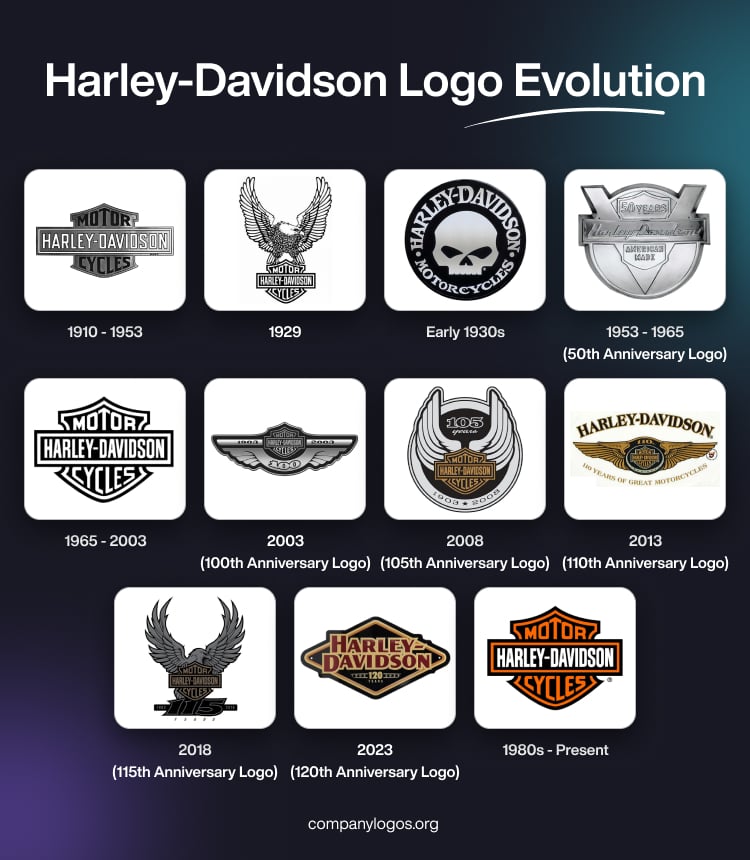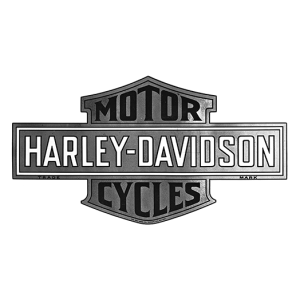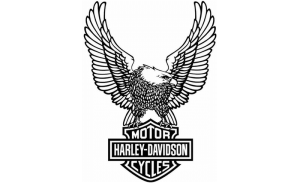
Harley-Davidson is the quintessential American motorcycle brand that represents quality, the spirit of adventure, and innovation. Founded in 1903 in Milwaukee, the motorcycles are a blend of modern technology and timeless design. The motorcycles offer an unparalleled experience of power, pride, and performance. The Harley-Davidson logo is one of the world’s most recognisable brand emblems.
Like the product itself, the logo symbolises freedom, power, and classic American craftsmanship for over a century. Its evolution showcases the journey of Harley-Davidson from a Milwaukee shed in 1903 to the global icon it is today. The article explores the various logo changes undertaken by the company, among other details of the company.
The Genesis of the Harley-Davidson Logo (1903 – 1910) (Unavailable)
Although the company was founded in the year 1903 in a shed, it did not have any logo or visual identity till 1910. In fact, “Harley-Davidson Motor Company” was just painted or stamped onto the motorcycle in plain typography.
(1910 – 1953)
In 1910, the original logo of Harley-Davidson came into existence with the now-iconic “Bar and Shield” emblem. This simple yet bold design consisted of a horizontal bar, inscribed with “Harley-Davidson,” in white uppercase and in a bold traditional typeface.
It was laid over a shield with the words “Motor” and “Cycles” in black uppercase displayed in both upper and lower parts. The colour palette utilised black, grey, and white with a gradient to convey strength and dependability. The horizontally oriented bar represented stability, while the shield signified protection.

(1929)
To face the challenges posed by the Great Depression, Harley-Davidson redesigned its logo by introducing an eagle to the bar and shield design. This was done as the eagle is the national symbol of the USA and symbolises liberty, courage, and independence.

(Early 1930s)
Although the skull logo was an unofficial one, it became quite popular, especially with a group of riders called “Outlaws.” It featured a white skull with black accents against a circular black background. The brand name in white uppercase was written around the edge of the circle.

(1953 – 1965) (50th Anniversary Logo)
In 1953, Harley-Davidson introduced a significant logo change to mark its 50th anniversary. The emblem in metallic chrome colour incorporated a large, stylised “V” behind the Bar and Shield to honour its famed V-twin engine. The anniversary medallion included “50 YEARS” and “AMERICAN MADE” inscriptions in custom cursive typography, while the logo itself took on a more robust, metallic look.

(1965 – 2003)
In 1965, the logo comprising the bar and shield was turned monochrome. The bar and shield emblem were refined and made to look masculine and powerful.

(2003) (100th Anniversary Logo)
The centenary celebration of the company resulted in a logo that had the bar and shield emblem enclosed within a circular frame with two wings. To the left of the wing was written “1903,” while the right mentioned “2003.” The numerals “100” were written in an arched way and placed under the shield emblem.

(2008) (105th Anniversary Logo)
The 2008 anniversary logo was designed to mark 105 years of the company. The “105 years” inscription is written above the emblem to form a crown. The dates 1903 – 2008 were placed at the bottom of the emblem with a star separating the numbers.

(2013) (110th Anniversary Logo)
The 2013 logo iteration was made to celebrate the 110th anniversary. It featured the usual double-winged logo in mustard colour, but with the inscription “110” at the top against a black background. On top of the emblem was written the name of the company in a black sans-serif typeface with shadows. At the bottom of the emblem was written “110 YEARS OF GREAT MOTORCYCLES.”

(2018) (115th Anniversary Logo)
The 115th anniversary logo was designed in 2018 and saw the return of the bald eagle holding the bar and shield emblem in its claws. A large “115” inscription was placed in front of the bar and shield emblem with “1903” and “2018” placed on the left and right. Also, the word “YEARS” is placed at the bottom of the logo.

(2023) (120th Anniversary Logo)
In 2023, the 120th anniversary logo was unveiled. It featured the brand name in red and yellow colours in two levels and set against a black rhombus with a thick mustard yellow outline.

(1980s – Present)
The current logo is a remake of the original logo of 1910 but with refinement. It features the bar and shield logo surrounded by a thin black outline. Here, the brand name in white is placed at the centre against a black background and delineated by orange colour. The words “MOTOR” and “CYCLES” were mentioned in the upper and bottom parts of the shield in orange lettering and outline.

The Elements of the Harley-Davidson Logo
Font
Most Harley-Davidson logos have featured sans-serif typefaces that have had stylish and blocky appearances.
Colour
The current Harley-Davidson logo displays a black and orange theme. Here, black exudes a sense of class, simplicity, elegance, and sleekness. Alternatively, black can also bring about an edginess that can go well with riding. Orange, on the other hand, exudes energy, creativity, personality, and enthusiasm. There is a subtle touch of white as well to promote purity and balance.
The History of Harley-Davidson
Harley-Davidson is a legendary American motorcycle manufacturer founded in Milwaukee, Wisconsin, in 1903 by William S. Harley and the Davidson brothers—Arthur, Walter, and William A. Davidson. The founders built their first motorcycle in a small shed and released it in 1905. In 1906, growing demand led to their first actual factory on Chestnut Street, Milwaukee. By 1907, Harley-Davidson was officially incorporated, and the founders focused on producing reliable, high-quality machines. In 1909, they introduced their first V-Twin engine, a hallmark that would become the brand’s engineering signature.
Harley-Davidson quickly expanded production and reached over 3,000 motorcycles annually by 1910. The company led motorcycle racing by sponsoring early racing teams. For instance, the famous “Wrecking Crew” was quick to embrace technological advances, such as the patented “Ful-Floteing Seat” in 1912 and the refined V-Twin engine in 1911.
Harley-Davidson thrived during the world wars by supplying tens of thousands of motorcycles to the U.S. Army and Allied forces, which helped establish its global reputation. Despite the hardships of the Great Depression, Harley-Davidson was one of only two American manufacturers to survive. It could do so through cost-cutting, engineering improvements, and steadfast support from dealers and customers.
After the Second World War, Harley-Davidson benefited from strong demand, especially among returning GIs. The company embraced both innovation, that is, the introduction of new engine designs like the Knucklehead (1936) and Panhead (1948), as well as the growing “motorcycle culture” of the 1950s and 1960s. Its motorcycles stood for their engineering and their role in Americana, Hollywood, and youth movements.
The AMF years (1969–1981) brought quality control issues and financial instability. However, after a management buyout in the 1980s, Harley-Davidson refocused on quality, heritage, and aggressive marketing. It could rebuild customer loyalty and become a symbol of rugged independence.
Into the 21st century, Harley-Davidson celebrated major milestones with special edition motorcycles and its enduring “Bar and Shield” logo. The brand diversified its lineup with new models. It embraced global markets, introduced advanced technology (fuel injection, liquid cooling), and cultivated a worldwide community through the Harley Owners Group (H.O.G.). The historic Juneau Avenue headquarters in Milwaukee remains active, and the Harley-Davidson Museum attracts enthusiasts from everywhere.
Interesting Facts About Harley-Davidson
- Harley-Davidson was founded in 1903 in a 10×15-foot wooden shed in Milwaukee, Wisconsin. The words “Harley-Davidson Motor Company” were scrawled on the door in pencil.
- Harley-Davidson is one of only two American motorcycle manufacturers to survive the Great Depression. The other was Indian, which eventually went bankrupt but was later revived.
- During World Wars I and II, Harley-Davidson supplied thousands of motorcycles to the U.S. military. In the Second World War alone, it produced over 90,000 WLA models to earn the nickname “The Liberator.”
- The famous Bar and Shield logo was first used in 1910 and officially trademarked in 1911. It has become one of the most recognised logos in the world.
- The Harley Owners Group (H.O.G.) was established in 1983 and is now one of the world’s largest factory-sponsored motorcycle clubs. It boasts over a million members globally.
- Harley-Davidson became a symbol of rebellion and counterculture after movies like “The Wild One” (1953) and “Easy Rider” (1969). It became the preferred brand of bikers, outlaws, and freedom seekers.
- Harleys are famous for their customisation potential. Riders often modify their bikes to make them unique. It is a tradition that helped spawn the chopper culture of the 1960s and 70s.
- In the late 1970s, the quality of Harley-Davidson suffered under AMF ownership. By 1981, a group of 13 executives bought the company back and revived it by focusing on quality and branding.
- In 2019, Harley-Davidson launched its first electric motorcycle, the LiveWire. It marked a bold step into the future, with cutting-edge performance but retaining the Harley spirit.
- In 2003, Harley celebrated its 100th anniversary with global events, which included a massive party in Milwaukee. Riders came from all over the world, riding thousands of miles to attend.
- Harley-Davidson’s merchandise sales, be it clothing or collectibles, make up a significant part of its revenue. The brand has become a lifestyle, not just a motorcycle company.
- Harley is known for its signature V-twin engines, which produce a deep, rumbling sound that is instantly recognisable. That “potato-potato” idle sound is loved by Harley fans.
- Harley-Davidson once tried to trademark the sound of its V-twin engine in the 1990s, but the application was ultimately dropped after legal challenges.
- Harley-Davidson motorcycles have been featured in U.S. parades, Hollywood films, museums, and even postage stamps.
- Though an American brand at heart, Harley-Davidson sells motorcycles in over 90 countries and has production facilities in India, Brazil, and Thailand, in addition to the U.S.
Finally
The Harley-Davidson logo has become one of the most enduring symbols in American pop culture. Its Bar and Shield design represents over a century of craftsmanship, rebellion, and freedom. The company has shown that consistency, with occasional tasteful evolution, can build a legendary brand identity. Thus, from the back roads of America to the highways of Europe and beyond, the Bar and Shield continues to inspire loyalty, passion, and pride among riders worldwide.